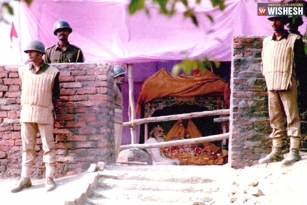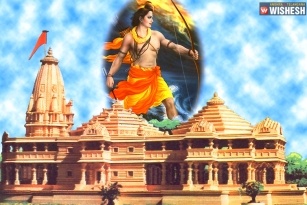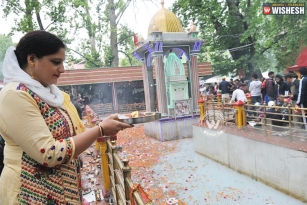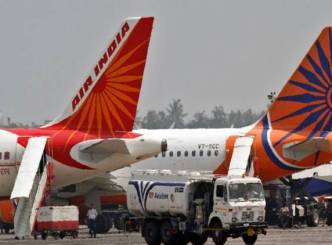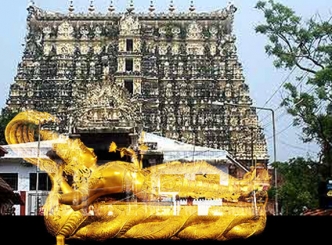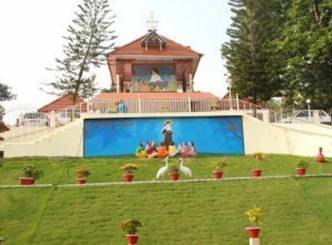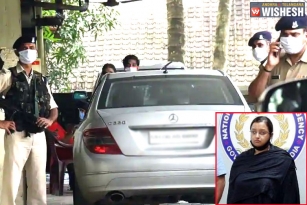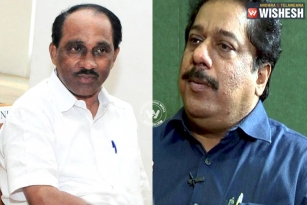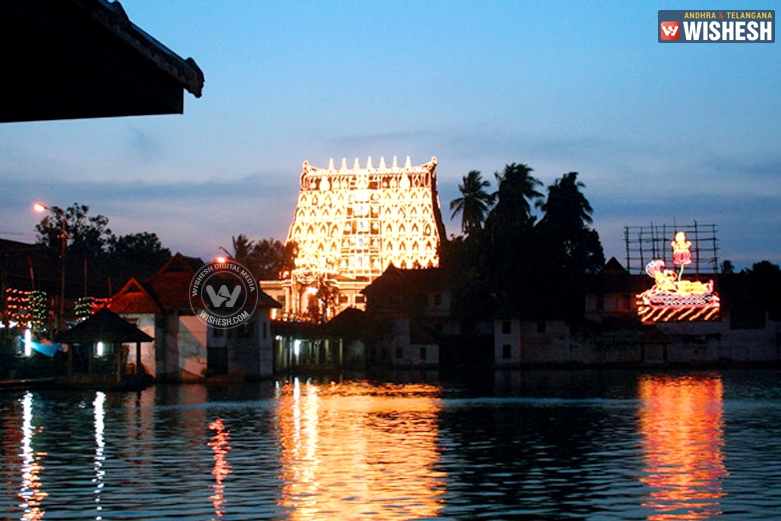
The Sri Padmanabha Swamy temple is considered as the richest temple in the world after the evaluation of the treasure found in the different vaults. In terms of precious metals and precious stones, it is by far the wealthiest institution and place of worship of any kind in the recorded history of the world. The temple is situated in the heart of the capital city Thiruvananthapuram, in the Indian state of Kerala. The name of the city is also derived from the presiding deity. The temple is located at Lattitude:8.483026 and Longitude: 76.943563.
This temple is a blend of the Kerala and Dravidian styles of architecture. The temple is built in the Dravidian style of architecture associated with the temples in the neighboring state of Tamil Nadu, featuring high walls and a 16th-century Gopuram. The principal deity Vishnu is enshrined in the "Anantha Sayanam" posture, the eternal yogic sleep on the serpent Adisheshan.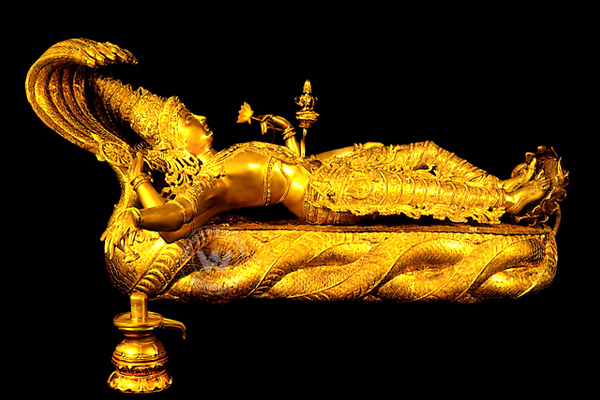
How to reach
Air: The Thiruvananthapuram airport is just Six KM away. There are plenty of Domestic and International flights from this airport.
Rail: Thruvananthapuram Railway station is just One KM from the temple. It is a walkable distance.
Bus: Thiruvananthapuram Bus stand is just opposite the railway station and is only One KM from the temple.
Road: The temple itself is in the heart of the city and hence can travel to the temple in all classes of transport.
History
The Sri Padmanabha Swamy temple finds mention in the Hindu texts like the Brahma Purana, Matsya Purana, Varaha Purana, Skanda Purana, Padma Purana, Vayu Purana, Bhagavata Purana and the Mahabharata. The Temple has been referred several times in the Sangam Period of Tamil literature between 500 B.C and 300 A.D. Sangam period texts and poetry and later ones by Nammalwar, addresses the Temple and the entire city as made of gold.
Medieval Tamil literature canon of the Tamil Alvar saints (6th–9th centuries AD), has mentioned the temple as one of the 108 principal Divya Desams ("Holy Abodes") in Vaishnavism and is glorified in the Divya Prabandha. The Divya Prabandha glorifies this shrine as being among the 13 Divya Desam in Malai Nadu (corresponding to present-day Kerala and some adjoining areas). The 8th century Alvar Nammalvar sang the glories of Padmanabha.
The well known sage Vilvamangalathu Swamiyar, who was residing near the Ananthapuram Temple in Kasargod District, prayed to Lord Vishnu for his darshan or "auspicious sight". The Lord appeared in the guise of a little boy who was mischievous. The boy defiled the Idol which was kept for Puja. The sage became enraged at this and chased away the boy, who disappeared. The sage realized his mistake and understood that the boy was Lord in disguise. He begged for pardon. A heavenly voice told that if he want to see him, he has to come to Ananthankadu. The sage set out to the Ananthankadu.
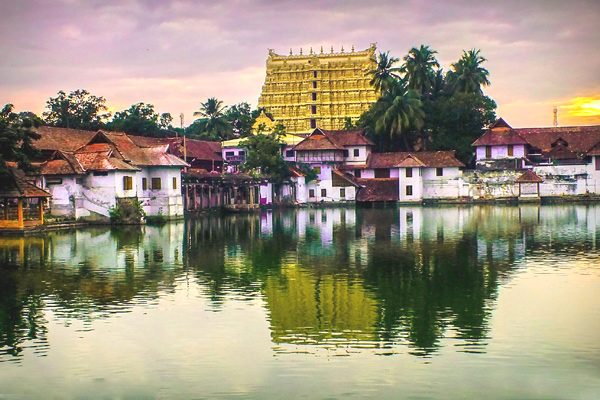
After a long search, when he was walking on the banks of the Arabian Sea, he heard a pulaya lady threatening her child that she would throw him in Ananthankadu, if does not obey her. The moment the sage heard the word Ananthankadu he was delighted. He proceeded to Ananthankadu based on the directions of the lady. The Sage reached Ananthankadu and started searching for the boy. There he saw the boy merging into an Iluppa tree (Indian Butter Tree). The tree fell down and became Anantha Sayana Moorti (Vishnu reclining on the celestial snake Anantha). The edifice that the Lord assumed was of an extraordinarily large size, with His head at Thiruvallom, navel at Thiruvanananthapuram, and lotus-feet at Thrippadapuram (Thrippappur), making him some eight miles in length.
The Sage requested the Lord to shrink to a smaller proportion that would be thrice the length of his staff. Immediately the Lord shrank to the form of the Idol that is seen at present in the Temple. Many Iluppa trees obstructed a complete vision of the Lord. The Sage saw the Lord in three parts – thirumukham, thiruvudal and thrippadam. The sage prayed to Padmanabha to be forgiven. The sage offered Rice Kanji and Uppumanga (salted mango pieces) in a coconut shell to the deity, which he had obtained from the pulaya woman. The spot where the Sage had darsan of the Lord belonged to Koopakkara Potti and Karuva Potti. With the assistance of the reigning King and some Brahmin households a Temple was constructed. Koopakkara Potti was made the Tantri of the Temple. The Ananthankadu Nagaraja Temple still exists to the north west of the Padmanabhaswamy Temple. The Samadhi (final resting place) of the sage exists to the west of the Padmanabha Temple.
In the first half of the 18th century, in line with matrilineal customs, Anizham Thirunal Marthanda Varma, succeeded his uncle Rama Varma as king at the age of 23, as the Rajah of Travancore. The last major renovation of the Sri Padmanabha Swamy temple commenced immediately after Anizham Thirunal's accession and the idol was reconsecrated in 906 ME (1731 CE). On 17 January 1750, Anizham Thirunal surrendered the kingdom of Travancore to Sri Padmanabha Swamy and pledged that he and his descendants would serve the kingdom as Sri Padmanabha Dasa. Since then, the name of every Travancore king was preceded by the title Sree Padmanabha Dasa. The female members of the royal family were called Sree Padmanabha Sevini. The donation of the kingdom to Sri Padmanabha Swamy was known as Thrippadi-danam.
The final wishes of Anizham Thirunal on his passing at the age of 53 clearly delineated the historical relationship between the Maharaja and the temple: "That no deviation whatsoever should be made in regard to the dedication of the kingdom to Sri Padmanabha Swamy and that all future territorial acquisitions should be made over to the Devaswom."
Deities in the temple
Sree Padmanabhaswamy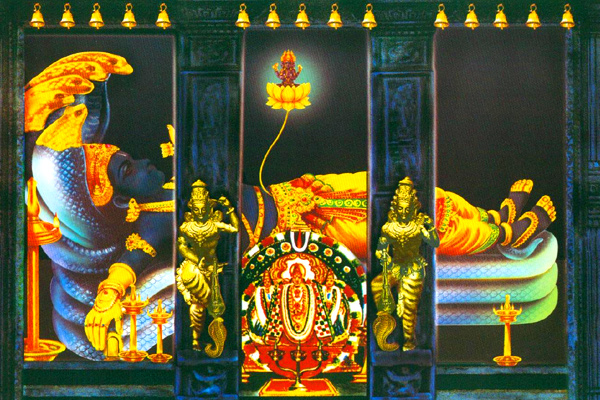
The marvelous idol of Sree Padmanabhaswamy is seen reclining on the mighty five hooded serpent Anantha. The supreme God is in conscious cosmic slumber with the head positioned to the south and the feet to the north. The serpent God Anantha spreads its hoods above the head of the Idol. The three coils represent the three characteristics of mankind Sattva, Rajas and Tamas and its five hoods indicate the Panchendriyas (five senses) or the five elements (Panchabhootas). From the navel of the Lord emerges a lotus on which Lord Brahma, the Creator, is seated. Just below the stretched right arm of the Lord is the Shiva Linga representing the Destroyer. Brahma, Vishnu (Padmanabha) and Shiva represent the ‘Srushti, Stithi and Samharam’.
The residing potency was drawn from the original Idol which was made of Iluppa wood and infused into the present Idol by certain complicated religious ritualistic processes. The Idol is made up of a highly complex amalgam termed as Katusarkarayogam and contains within it 12008 Salagramas collected from the bed of the River Gandaki in Nepal. It is believed that Salagramas represent the Lord Vishnu and twelve Salagramas together gain the potency of a Mahakshetram (Great Temple). Thus the mighty Ananthasayana Moorthy here gains the greatness and sanctity of a thousand Mahakshetrams.
The sanctum sanctorum has three entrances representing the three stages of times. Through those doors we can observe the Deity.
Vishwaksenan
This idol in sitting posture, facing the South and is given great prominence as Vishwaksenan is Mahavishnu’s Nirmalya moorthy.
Sree Ramaswamy with His consort Seetha and brother Lekshmanan
There are two sets of idols of Sree Ramaswamy with Seetha and Lekshmanan. One set of idols are in the regal style while the other represent the Lord’s tenure at Dandakaranyam (Forest). The image of Sree Hanuman is there as an orderly to Lord Rama. Idols of an eight armed Ganapathy with a Devi seated on His lap and a small Kaliyamardana Krishna are also present.
Sree Yoga Narasimha Moorthi
The shrine for Sree Narasimha Swamy is located to the South of the main sanctum. Sree Narasimha Moorthy is the fourth incarnation of Lord Maha Vishnu and assumes the form of Man and Lion. The image is in the ‘Ugra roopam’ and hence powerful. To pacify Him, Ramayana is being recited throughout the time when the Temple doors are open. This idol is made of Panchaloham and faces the East.
Sree Veda Vyasar and Ashwathama
The shrine of Sage Veda Vyasar (who gave life to the great Epic Mahabharatha and other religious texts) along with Ashwathama is located on the north of the cheruchuttu. This shrine faces the West. Both idols are made of Panchaloham.
Thiruvambadi Sreekrishnaswamy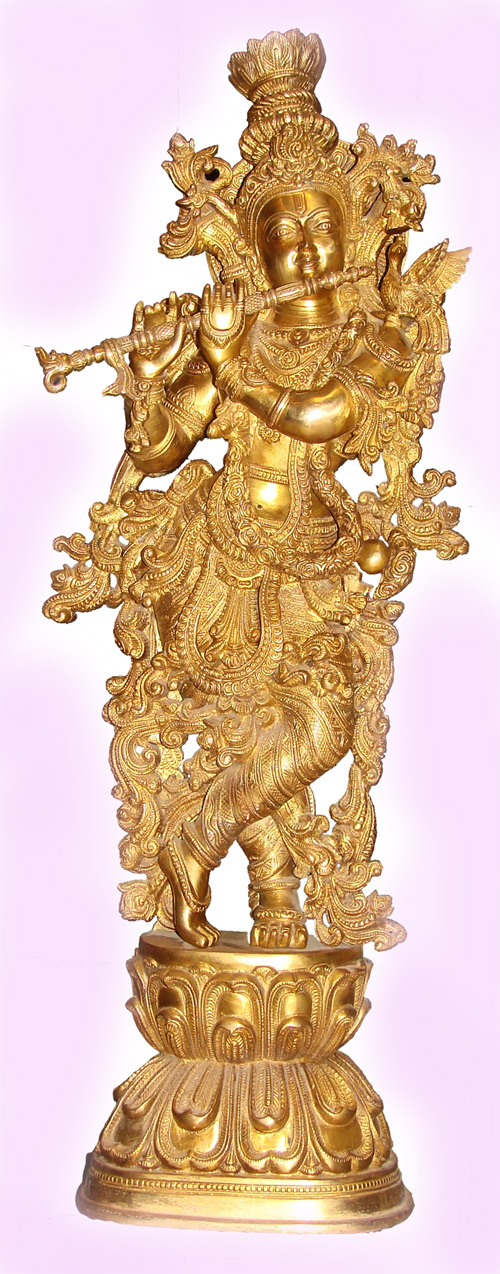
The Thiruvambadi Sri Krishna Temple enjoys the status of an independent temple within this Temple complex. This shrine has a Namaskara Mandapam with a fine display of carvings in wood, a Balikkal and a silver flag pole. The image of Sree Krishna as Parthasarathy is the deity.
Kshethrapaalakan
The idol of the Kshethrapaalakan in the sitting posture faces the East. The shrine is located on the Northern side of the Temple. Kshethrapaalakan is considered as one of the eight Bhairavas of Shiva, who performs the role as protector of the temples. There is also an idol of Lord Ganesha, in this shrine.
Agrashaala Ganapathi
This idol is installed in the cooking area of the Temple. The belief is that Lord Ganesh witnesses and oversees the Annadanam (offering of free food) organized by the Temple.
Hanuman Swamy, Ashtanaga Garuda Swamy and the Maha Meru Chakram
Near the golden flag pole, there is the towering image of Sree Hanuman Swamy in full relief. To His left is Sree Ashtanaga Garuda Swamy. On the ceiling between these images is the Maha Meru Chakram complete with the Bindu or the central point which is engraved in clear focus. This cosmic wheel enhances the spiritual strength of Sree Hanuman.
Sree Dharma Sastha
The Swayambhu Dharma Sastha in Yogasanam or Yogic posture is on the South side of the Temple and is an independent shrine. This idol is made of granite and faces the East.
Rules and regulations to enter the temple
Only Hindus are permitted inside the temple.
There is a strict dress code that needs to be followed while entering the temple. Men have to wear mundu or dhoti (worn around the waist and going down up to the heels) and is not permitted to wear shirts or tops of any kind.
Women had to wear sari, mundum neriyathum (set-mundu), skirt and blouse or half sari.
Temple Darshan timings
Morning hours:
03:30 a.m. to 04:45 a.m. (Nirmalya Darshanam)
06:30 a.m. to 07:00 a.m.
8.30 a.m. to 10:00 a.m.
10:30 a.m. to 11:10 a.m.
11:45 a.m. to 12:00 Noon
Evening hours:
05:00 p.m. to 06:15 p.m.
06:45 p.m. to 07:20 p.m.
Please note that the temple timings are subject to change during festival time
Festivals
There are many festivals related to this temple. The major festivals are bi-annual.
Chingam 1st
Malayalam New Year Day attracts many devotees here.
Vinayaka Chathurthi
This event comes on the Chathurthi tithi on Karuthapaksham (New Moon) of Chingam. Special offerings and deeparadhana are conducted for the Ganesh idol in the Sree Rama Shrine. ‘Chirappu’ is observed for the Agrashala Ganapathi. The Valiya Thampuran (eldest male member of the royal family) worships here only on this day and witnesses the deeparadhana.
Thiruvonam
This is one among the most major celebrations of this Temple by virtue of the fact that it is the Thirunal (Birthday) of Sree Padmanabhaswamy. Of special note is the submission of the Onavillu to the Deities. It has a tradition of centuries behind it.
Ashtami Rohini
Sree Krishna’s birthday is celebrated all over India in the month of Chingam when the star Rohini and the thithi Ashtami coincide. Special decorations and offerings mark this day. The Temple opens early in the noon by 2 pm. At 2.30pm abhishekam of milk is performed to Sree Krishna. On this day an exquisitely decorated ivory cradle is placed on the Abhisravana Mandapam and number of images of Lord Krishna are kept inside for the devotees to view.
Navarathri Pooja
In connection with the Navarathri festival Sree Saraswathi Amman is brought from Padmanabhapuram Palace in Kanyakumari District and worshipped traditionally in the Navarathri Mandapam at the Valiya Kottaram complex. Sree Kumaraswamy from Kumarakovil and Sree Muthuttee Nanga from Suchindram also accompany Her in grand procession.
Valiya Ganapathi Homam
This is carried out for twelve days, starting two days before the commencement of the Navarathri Festival, by the Tharananalloor Namboodiripads who are Tantries of the Temple.
Alpasi Ulsavam
Sree Padmanabhaswamy Temple celebrates bi-annual festivals in the months of Thulam (Alppasi) and Meenam (Painkuni). The festival starts with Kodiyettu (flag hoisting) at Sree Padmanabhaswamy’s gold and Sree Krishnaswamy’s silver flag poles. The festival is of ten days, culminating in the spectacular Palliveta and Arat processions on the 9th and 10th days respectively.
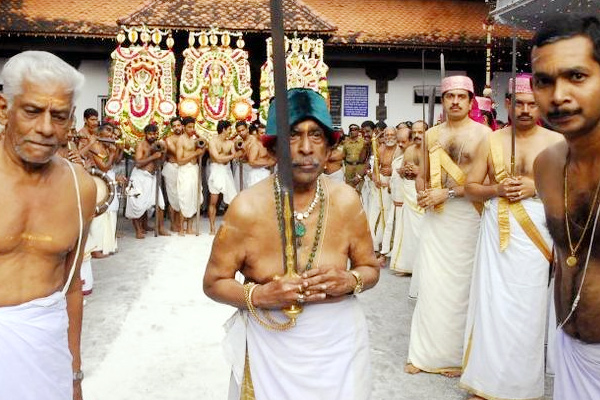
The Aarat procession slowly proceeds with pomp and pageantry, colour and music, men carrying divine emblems and insignias of royalty. History and heritage are re-lived. The procession reaches the Sanghumugham beach and the Vahanams are positioned in the Aarat Mandapam. Poojas are performed to the idols by the Tantri and the holy immersion in the sea takes place. After this, the procession returns to the Temple.
Mandala Chirappu
The celebration for the Dharma Sastha begins on the first of Vrischikam. Mandalachirappu falls on the 41st day.
Swargavathil Ekadasi
This is an auspicious day for the devotees of Maha Vishnu. Special poojas, offerings and night Siveli take place. The Temple remains open for longer duration.
Bhadradeepam
Bhadradeepam is observed in the summer and winter solstices. In these days Bhadradeepappura is opened and special poojas are made.
Kalabham
This is conducted for seven days commencing from the last six days of Dhanu and Midhunam. The ablution with sandal paste on the idols is the highlight of the function.
Makara Sreebali
A night Sreebali observed on winter solstice (Utharayanam).
Sivarathri
This is a day celebrated all over India as important for Sree Parameswara. On this day special Abhishekam is done to the Shiva residing in the Sanctum.
Painkuni Utsavam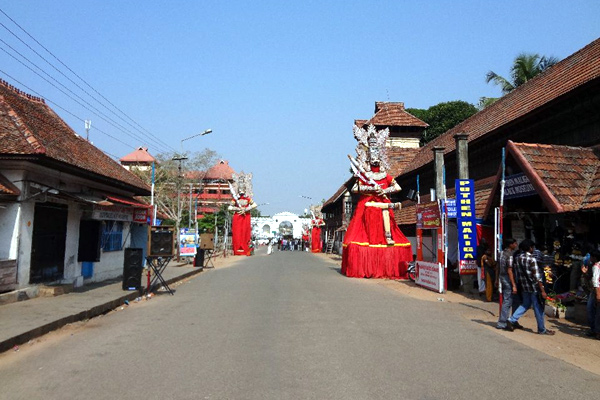
All the rituals and functions which take place for this Utsavam are same as for Alpasi Festival,. While prominence is given to the star Thiruvonam under which alone the Arat takes place for Alpasi, for Painkuni the emphasis is on the day of Kodiyettu (flag hoisting) on which the star is Rohini. In connection with this festival the massive figures of Pandavas are erected at the Eastern entrance of the Temple.
Sree Rama Navami
Special poojas are performed on this day for Sree Rama.
Vishu
Vishu is an extremely auspicious day for Keralites. Vishukani is arranged inside the sanctum of all shrines in this Temple complex. The Temple opens an hour earlier for Vishukkani Darshanam.
Karkataka Sreebali
On the first day of the Malayalam month Karkkitakam (Dakshinayanam) the Karkkitaka Sreebali takes place. Its procedure is same as the Makara Sreebali.
Sree Veda Vyasa Jayanthi
Sree VedaVyasa Jayanthi is celebrated on the full moon day of Karkkitakam in honour of the great sage Vyasa who resides in his separate shrine.
Niraputhari
On the day of Niraputhari sheaves of grain are ceremoniously brought to the Temple. The chief priest removes some sheaves from the bundle after performing pooja to the same and takes them inside the sanctum of Sree Padmanabha Swamy and submits them. Some sheaves are spread out on the Ottakkal Mandapam. This procedure takes place in all the other shrines of the Temple complex.
Murajapam
The very term reveals its meaning. ‘Mura’ means turn and ‘Japam’ means chanting. This prayer lays tremendous stress on the chanting of Vedas and the Vishnu Sahasranamam. It is celebrated once in six years. It comprises 56 days of Veda chanting, Sahasranama Japam and rituals.
Lakshadeepam
Lakshadeepam literally translates as lakh lamps. The entire Temple is adorned with lamps. The Sreebali (Procession) conducted with illumination on the concluding day of Murajapam is known as Lakshadeepam. The maiden Lakshadeepam was celebrated on the 1st of Makaram 925 ME / 14th or 15th of January 1750 AD. The festival was conducted with much pomp and fanfare, in the grandest manner possible by King Marthanda Varma. The latest Lakshadeepam was celebrated in 2014. The next one is due in 2020. It still continues as an immensely grand festival and visual magnitude.
By Premji


